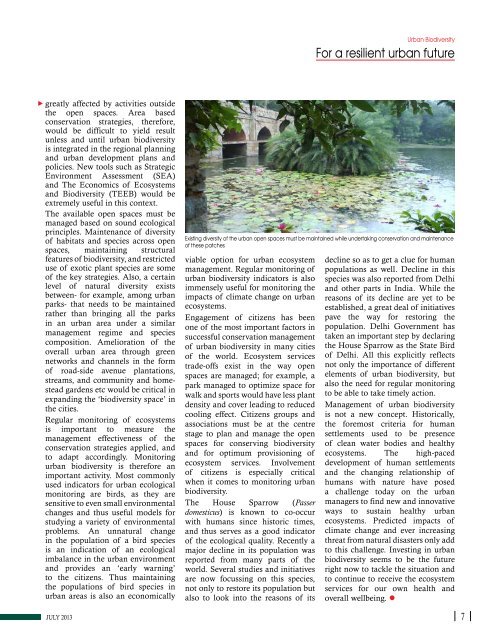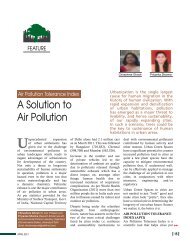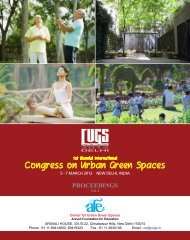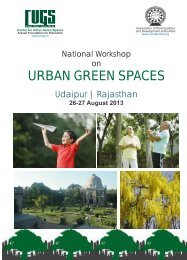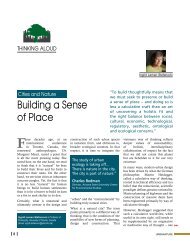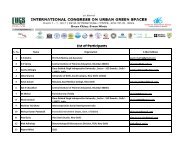Sustainability and the City - Center for Urban Green Spaces
Sustainability and the City - Center for Urban Green Spaces
Sustainability and the City - Center for Urban Green Spaces
Create successful ePaper yourself
Turn your PDF publications into a flip-book with our unique Google optimized e-Paper software.
<strong>Urban</strong> BiodiversityFor a resilient urban futuregreatly affected by activities outside<strong>the</strong> open spaces. Area basedconservation strategies, <strong>the</strong>re<strong>for</strong>e,would be difficult to yield resultunless <strong>and</strong> until urban biodiversityis integrated in <strong>the</strong> regional planning<strong>and</strong> urban development plans <strong>and</strong>policies. New tools such as StrategicEnvironment Assessment (SEA)<strong>and</strong> The Economics of Ecosystems<strong>and</strong> Biodiversity (TEEB) would beextremely useful in this context.The available open spaces must bemanaged based on sound ecologicalprinciples. Maintenance of diversityof habitats <strong>and</strong> species across openspaces, maintaining structuralfeatures of biodiversity, <strong>and</strong> restricteduse of exotic plant species are someof <strong>the</strong> key strategies. Also, a certainlevel of natural diversity existsbetween- <strong>for</strong> example, among urbanparks- that needs to be maintainedra<strong>the</strong>r than bringing all <strong>the</strong> parksin an urban area under a similarmanagement regime <strong>and</strong> speciescomposition. Amelioration of <strong>the</strong>overall urban area through greennetworks <strong>and</strong> channels in <strong>the</strong> <strong>for</strong>mof road-side avenue plantations,streams, <strong>and</strong> community <strong>and</strong> homesteadgardens etc would be critical inexp<strong>and</strong>ing <strong>the</strong> ‘biodiversity space’ in<strong>the</strong> cities.Regular monitoring of ecosystemsis important to measure <strong>the</strong>management effectiveness of <strong>the</strong>conservation strategies applied, <strong>and</strong>to adapt accordingly. Monitoringurban biodiversity is <strong>the</strong>re<strong>for</strong>e animportant activity. Most commonlyused indicators <strong>for</strong> urban ecologicalmonitoring are birds, as <strong>the</strong>y aresensitive to even small environmentalchanges <strong>and</strong> thus useful models <strong>for</strong>studying a variety of environmentalproblems. An unnatural changein <strong>the</strong> population of a bird speciesis an indication of an ecologicalimbalance in <strong>the</strong> urban environment<strong>and</strong> provides an ‘early warning’to <strong>the</strong> citizens. Thus maintaining<strong>the</strong> populations of bird species inurban areas is also an economicallyExisting diversity of <strong>the</strong> urban open spaces must be maintained while undertaking conservation <strong>and</strong> maintenanceof <strong>the</strong>se patchesviable option <strong>for</strong> urban ecosystemmanagement. Regular monitoring ofurban biodiversity indicators is alsoimmensely useful <strong>for</strong> monitoring <strong>the</strong>impacts of climate change on urbanecosystems.Engagement of citizens has beenone of <strong>the</strong> most important factors insuccessful conservation managementof urban biodiversity in many citiesof <strong>the</strong> world. Ecosystem servicestrade-offs exist in <strong>the</strong> way openspaces are managed; <strong>for</strong> example, apark managed to optimize space <strong>for</strong>walk <strong>and</strong> sports would have less plantdensity <strong>and</strong> cover leading to reducedcooling effect. Citizens groups <strong>and</strong>associations must be at <strong>the</strong> centrestage to plan <strong>and</strong> manage <strong>the</strong> openspaces <strong>for</strong> conserving biodiversity<strong>and</strong> <strong>for</strong> optimum provisioning ofecosystem services. Involvementof citizens is especially criticalwhen it comes to monitoring urbanbiodiversity.The House Sparrow (Passerdomesticus) is known to co-occurwith humans since historic times,<strong>and</strong> thus serves as a good indicatorof <strong>the</strong> ecological quality. Recently amajor decline in its population wasreported from many parts of <strong>the</strong>world. Several studies <strong>and</strong> initiativesare now focussing on this species,not only to restore its population butalso to look into <strong>the</strong> reasons of itsdecline so as to get a clue <strong>for</strong> humanpopulations as well. Decline in thisspecies was also reported from Delhi<strong>and</strong> o<strong>the</strong>r parts in India. While <strong>the</strong>reasons of its decline are yet to beestablished, a great deal of initiativespave <strong>the</strong> way <strong>for</strong> restoring <strong>the</strong>population. Delhi Government hastaken an important step by declaring<strong>the</strong> House Sparrow as <strong>the</strong> State Birdof Delhi. All this explicitly reflectsnot only <strong>the</strong> importance of differentelements of urban biodiversity, butalso <strong>the</strong> need <strong>for</strong> regular monitoringto be able to take timely action.Management of urban biodiversityis not a new concept. Historically,<strong>the</strong> <strong>for</strong>emost criteria <strong>for</strong> humansettlements used to be presenceof clean water bodies <strong>and</strong> healthyecosystems. The high-paceddevelopment of human settlements<strong>and</strong> <strong>the</strong> changing relationship ofhumans with nature have poseda challenge today on <strong>the</strong> urbanmanagers to find new <strong>and</strong> innovativeways to sustain healthy urbanecosystems. Predicted impacts ofclimate change <strong>and</strong> ever increasingthreat from natural disasters only addto this challenge. Investing in urbanbiodiversity seems to be <strong>the</strong> futureright now to tackle <strong>the</strong> situation <strong>and</strong>to continue to receive <strong>the</strong> ecosystemservices <strong>for</strong> our own health <strong>and</strong>overall wellbeing. •July 20137


